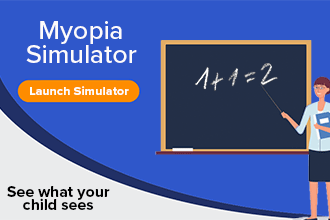Short-sightedness symptoms

The symptoms of short-sightedness (myopia) are some of the easiest to recognise among the common eye problems in adults or children. Short-sighted people can see nearby objects relatively clearly (usually somewhere around arm's length or closer), but struggle to see things that are farther away (such as across a room or across the street).
Symptoms of short-sightedness can include:
Blurry vision when looking at objects that are farther away
Squinting or screwing up eyes to see clearly
Headaches (a result of eye strain)
Difficulty driving
Short-sightedness is an increasingly common problem. About 25% of people in Australia and New Zealand are short-sighted, according to the Australian Institute of Health and Welfare.
Download a printable checklist of myopia signs and symptoms HERE.
SEE RELATED: What causes short-sightedness?
Symptoms of short-sightedness in children
Short-sightedness often begins in childhood, and it’s important to have it diagnosed as early as possible as the earlier it starts the more likely it is to progress to high levels. In addition to prescription glasses, an optometrist can now suggest a variety of treatments including new styles of spectacle lenses to help minimise the risk of high myopia later in life.
It can be harder for children to recognise that something is wrong with their eyesight, so myopia symptoms in children are slightly different than the symptoms in adults.
Parents should be mindful of symptoms like:
Excessive blinking
Eye rubbing
Frequent squinting or screwing up their eyes
Sitting closer to objects like TV screens or classroom boards (sometimes teachers may think the child is being disruptive as they may walk up to the front of the class to see things on the board more clearly)
Being less aware (or completely unaware) of distant objects
Children who are short-sighted must have regular eye exams so they can be offered the options to help control their myopia and help maintain healthy vision during their school years. Myopia generally stabilises sometime before age 20, but it can continue to progress or even develop in early adulthood.
When to see an optometrist
Even low levels of short-sightedness can pose a risk to eye health, but the more progressive the myopia and the higher the prescription, the greater the risk. If a child’s myopia worsens with age, it can increase their risk of developing sight-threatening conditions later in life such as retinal detachments or myopic macular degeneration. Even in their younger years, depending on the level of their short-sightedness, a child can be at risk of a retinal detachment in some situations.
Early diagnosis and treatment of short-sightedness can minimise their chances of developing these problems. Make sure to schedule an eye exam if your child is showing any of the symptoms of myopia.
In adults, once their myopia has stabilised, symptoms can usually easily be corrected with prescription glasses or contact lenses. These corrective lenses require a prescription, which your optometrist will provide after a comprehensive eye examination.
Optional procedures such as LASIK and PRK may be used to correct short-sightedness but even these do not reduce the risks posed by higher levels of myopia.
READ MORE: Can myopia lead to blindness?
Page published on Tuesday, 17 March 2020
Page updated on Tuesday, 31 January 2023








